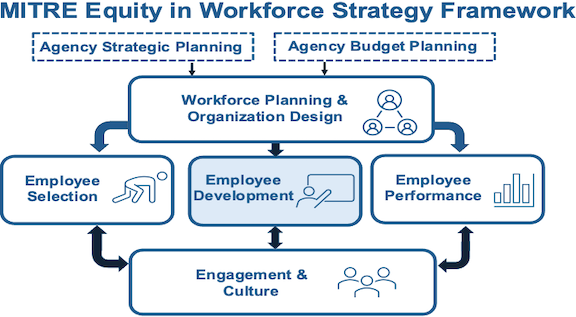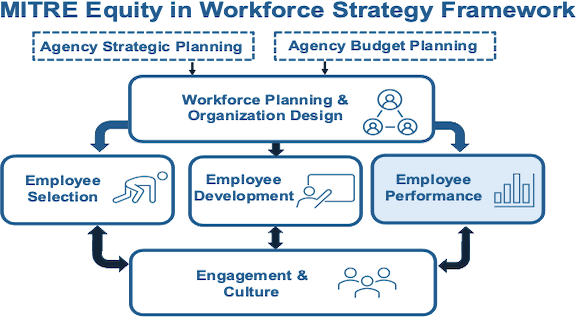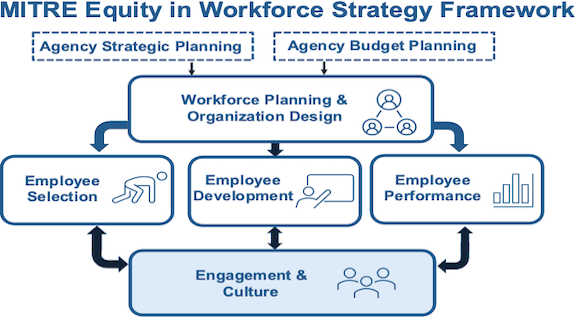| Priority | Framework strategies | Score |
|---|
| Priority | FOCSE Commponent | Score |
|---|






Workforce Planning & Organization Design
Workforce planning and organization design aligns investments in the workforce with organizational
strategic planning. The planning process identifies and addresses the gaps between the workforce of
today and the human capital needs of tomorrow. This is in conjunction with the organization design
process, which drives decisions about the configuration of the formal structures, processes, and
systems. Both are critical to setting the workforce strategy and investments.
Important aspects for addressing equity include:
Workforce planning analysis evaluates the current diversity profile of the workforce
Considering barrier analysis when developing plans for future workforce investments
Using position management to develop an organization design that allows for mobility through
career ladders for underrepresented groups
Using workforce planning demand and supply data to inform diversity and inclusion strategies and
plans
Aligned FEVS Question(s):
Managers promote communication among different work units (for example, about projects, goals,
needed resources).
Managers support collaboration across work units to accomplish work objectives.
I have enough information to do my job well.
My talents are used well in the workplace.
Key questions to consider to address equity:
How does diversity, equity and inclusion (DEI) strategies align and integrate with
organizational strategies and workforce plans?
Are DEI workforce requirements directly related to the agency’s strategic and annual business
plans?
Does the agency have a comprehensive picture of where gaps exist between competencies in the
workforce currently and future competency requirements?
Does the agency use workforce demand requirements to make decisions about how best to structure
the organization and deploy the workforce?
How does the agency identify and overcome internal and external barriers to accomplishing
strategic DEI workforce goals?
What are the appropriate skill sets and occupational series? What grade levels? How is the
agency ensuring there is equal opportunity and representation in each series?
How many people does the agency need? What is the organizational structure that fits the mission
outcomes? How will it be supported?
Employee Selection
Employee recruitment and selection procedures are used as a basis for making employment decisions
related to hiring and promotion. Equity in employee recruitment and selection is a legal imperative
reflected in the Uniform Guidelines on Employee Selection Procedure. Federal agencies are required to
recruit from a diverse, qualified group of potential applicants to secure a high-performing workforce
drawn from all segments of American society. This element includes recruiting develop strategies to
attract talent to the organization, conducting a job analysis to determine the competencies required
or hiring, developing an assessment strategy for selecting the candidates, and the design of
assessment instruments.
Important aspects for addressing equity include:
Developing an assessment strategies that are fair and unbiased with linkages to job needs
Providing transparent processes that allow employees to compete for job opportunities
Actively recruiting from a diverse applicant pool
Aligned FEVS Question(s):
My supervisor is committed to a workforce representative of all segments of society.
Arbitrary action, personal favoritism and coercion for partisan political purposes are not
tolerated.
Prohibited Personnel Practices (for example, illegally discriminating for or against any
employee/applicant, obstructing a person's right to compete for employment, knowingly violating
veterans' preference requirements) are not tolerated.
Key questions to consider to address equity:
How does the agency design and perform strategic outreach and recruitment to reach all segments
of society?
How does the agency collect and analyze applicant flow data from workforce diversity mix?
How does the agency coordinate outreach and recruitment strategies to maximize ability to
recruit from a diverse, broad spectrum of potential applicants, including a variety of geographic
regions, academic sources, and professional disciplines?
How do we ensure that outreach and recruitment strategies designed to draw from all segments of
society, including those who are underrepresented, are employed when using staffing flexibilities
and alternative hiring authorities?
How do we develop strategic partnerships with a diverse range of colleges and universities,
trade schools, apprentice programs, and affinity organizations from across the country?
Do we involve managers and supervisors in recruitment activities and take appropriate action to
ensure that outreach efforts are effective in addressing barriers?
Do we review and ensure that student internship and fellowship programs have diverse pipelines
to draw candidates from all segments of society?
Do we review results of barrier analyses required under MD 715, develop action plans to
eliminate any identified barrier(s), and coordinate implementation of action plans?
How do we use Schedule A hiring authority for people with disabilities and Veteran Hiring
Authorities as part of strategy to recruit and retain a diverse workforce?
Do we support Special Enhanced Programs (SEP) and appoint SEP Managers as advisors on hiring,
retaining and promoting a diverse workforce?
Employee Development
Employee development includes assessing the necessary skills to meet current and future job demands by
developing coaching and training interventions. This includes the design and assessment of both
technical and non-technical competencies, as well as leadership development. Some methods of employee
development occur on the job while other development occurs at training facilities or online methods
to develop employees.
Important aspects for addressing equity include:
Ensuring that training opportunities are equally distributed
Fairness in decisions for who is eligible for training resources
The creation of upward mobility for under-represented groups
Development of talent pipelines
Aligned FEVS Question(s):
I feel encouraged to come up with new and better ways of doing things.
My talents are used well in the workplace.
My supervisor provides me with constructive suggestions to improve my job performance.
In the last six months, my supervisor has talked with me about my performance.
Employees have a feeling of personal empowerment with respect to work processes.
Key questions to consider to address equity:
How do we promote diversity and inclusion in leadership development programs?
Do we ensure all employees have access to diversity and inclusion training and education,
including the proper implementation of the agency-specific diversity and inclusion strategic plan?
Are training opportunities equally distributed?
Is there fairness in decisions for who is eligible for training resources?
Are there upward mobility programs for under-represented groups?
How do we develop talent pipelines? How will you develop your leaders?
How can we create knowledge and transfer across your organization? How can we support a learning
organization?
How do we onboard and integrate new employees?
How will we keep technical skills current? How will you anticipate future needs?
Do you review leadership development programs, determine whether they draw from all segments of
the workforce, and develop strategies to eliminate barrier(s) where they exist?
Does the organization offer mentoring programs within agencies for employees at all levels with
an emphasis on aspiring Executive level employees?
Does the organization develop and implement a succession planning system for mission-critical
occupations that includes broad outreach to a wide variety of potential leaders?
Are leaders trained regarding relevant legal requirements?
Employee Performance
Employee performance includes all elements of the performance management cycle. Performance management
is the systematic process of planning work and setting expectations, monitoring performance,
developing the capacity to perform, rating performance, and rewarding good performance. While employee
performance is distinct from organizational performance, there are linkages to the measurement of
metrics and outcomes at the individual and organizational levels.
Important aspects for addressing equity include:
Setting expectations that are consistent across employees
Monitoring performance in a way that is fair across employees
Providing employees with the work assignments and opportunities
Using consistent standards for rewarding good performance
Rating performance regularly across all groups
Aligned FEVS Question(s):
In my work unit, steps are taken to deal with a poor performer who cannot or will not improve.
My supervisor is committed to a workforce representative of all segments of society.
In my work unit, differences in performance are recognized in a meaningful way.
Awards in my work unit depend on how well employees perform their jobs.
Creativity and innovation are rewarded.
Arbitrary action, personal favoritism and coercion for partisan political purposes are not
tolerated.
My supervisor provides me with constructive suggestions to improve my job performance.
In the last six months, my supervisor has talked with me about my performance.
Key questions to consider to address equity:
How does leadership demonstrate leadership accountability, commitment, and involvement regarding
diversity and inclusion in the workplace?
How do we measure performance?
What do we do to reward people?
How do we improve poor performance?
What points in the employees’ journey can help supervisors identify when to engage more?
How will this impact retention and future performance?
Is the value of workforce diversity and inclusion affirmed in each agency’s strategic plan and
include them in workforce planning activities?
Is there an agency-specific diversity and inclusion plan? Do we implement that plan, through the
collaboration and coordination of the Chief Human Capital Officer, the EEO Director, and agency
leadership?
Do all SES members, managers, supervisors and employees throughout the agency have performance
measures in place to ensure the proper execution of the agency’s strategic plan, which includes
diversity and inclusion?
Do we develop and widely distribute a set of diversity and inclusion measures to track agency
efforts and provide a mechanism for refining plans?
Engagement & Culture
Culture of an organization includes the values, norms, attitudes, beliefs and behavioral meanings that
are shared by members of group. Engagement specifies the connection that employees have to their work,
their organization, or the people they work and the effect of that connection to produce better
results for the organization.
Important aspects for addressing equity include:
Determining if there are signals that are sent to employees that signal cultural attributes
Identifying and addressing elements of culture that unfairly promote or deny benefits to certain
employees
Identifying whether cultural norms signal to certain employees that they are included or
excluded
Aligned FEVS Question(s):
I feel encouraged to come up with new and better ways of doing things.
My supervisor supports my need to balance work and other life issues.
My supervisor is committed to a workforce representative of all segments of society.
My supervisor listens to what I have to say.
My supervisor treats me with respect.
Managers promote communication among different work units (for example, about projects, goals,
needed resources).
Supervisors work well with employees of different backgrounds.
Creativity and innovation are rewarded.
Supervisors work well with employees of different backgrounds.
Employees have a feeling of personal empowerment with respect to work processes.
Managers support collaboration across work units to accomplish work objectives.
I have enough information to do my job well.
Key questions to consider to address equity:
Do employees feel that they are treated fairly?
Do we support participation in employee affinity and resource groups and provide such groups
with access to agency senior leadership?
Do we employ a diversity and inclusion dashboard with metrics as a tool for agency workforce
planning and reporting?
Do we recognize and hold to account cultural attributes that promote diversity, equity and
inclusion in the workplace?
Do we assess if elements of our culture unfairly promote or deny benefits to certain employees?
Do we address diversity, equity and inclusion is an essential part of culture and engagement? Do
we identify whether cultural norms signal to certain employees that they are included or excluded?
Do employees feel psychological safety in the workplace?/ol>
Do we apply flexible workplace policies that encourage employee engagement and empowerment,
including, but not limited to, telework, flexplace, wellness programs, and other work-life
flexibilities and benefits?
How do we cultivate a culture that encourages collaboration, flexibility, and fairness to
enable individuals to contribute to their full potential and further retention? Do we cultivate
a supportive, welcoming, inclusive and fair work environment?
Do we comply full and in a timely manner with all Federal laws, regulations, Executive orders,
management directives, and policies related to promoting diversity and inclusion in the Federal
workforce?
Do we submit timely reports to the U.S. Office of Personnel Management (OPM) reports required
by Federal laws, regulations, Executive orders, management directives, and policies. Where an
agency fails to do so, OPM will issue a Diversity and Inclusion Improvement Notice and notify
the President’s Management Council (PMC) of the deficiency?
- Do we apply flexible workplace policies that encourage employee engagement and empowerment,
including, but not limited to, telework, flexplace, wellness programs, and other work-life
flexibilities and benefits?
- How do we cultivate a culture that encourages collaboration, flexibility, and fairness to
enable individuals to contribute to their full potential and further retention? Do we cultivate
a supportive, welcoming, inclusive and fair work environment?
- Do we comply full and in a timely manner with all Federal laws, regulations, Executive orders,
management directives, and policies related to promoting diversity and inclusion in the Federal
workforce?
- Do we submit timely reports to the U.S. Office of Personnel Management (OPM) reports required
by Federal laws, regulations, Executive orders, management directives, and policies. Where an
agency fails to do so, OPM will issue a Diversity and Inclusion Improvement Notice and notify
the President’s Management Council (PMC) of the deficiency?